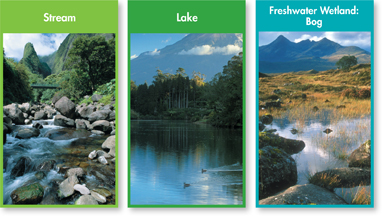Temperature and Currents Aquatic habitats, like terrestrial habitats, are warmer near the equator and colder near the poles. Temperature in aquatic habitats also often varies with depth. The deepest parts of lakes and oceans are often colder than surface waters. Currents in lakes and oceans can dramatically affect water temperature because they can carry water that is significantly warmer or cooler than would be typical for any given latitude, depth, or distance from shore.
Nutrient Availability As you learned in Chapter 3, organisms need certain substances to live. These include oxygen, nitrogen, potassium, and phosphorus. The type and availability of these dissolved substances vary within and between bodies of water, greatly affecting the types of organisms that can survive there.
MYSTERY CLUE 
What is one way in which life in Yellowstone's streams might be affected by the presence or absence of plants along stream banks?
Freshwater Ecosystems
 What are the major categories of freshwater ecosystems?
What are the major categories of freshwater ecosystems?
Only 3 percent of Earth's surface water is fresh water, but that small percentage provides terrestrial organisms with drinking water, food, and transportation. Often, a chain of streams, lakes, and rivers begins in the interior of a continent and flows through several biomes to the sea.  Freshwater ecosystems can be divided into three main categories: rivers and streams, lakes and ponds, and freshwater wetlands. Examples of these ecosystems are shown in Figure 4–21.
Freshwater ecosystems can be divided into three main categories: rivers and streams, lakes and ponds, and freshwater wetlands. Examples of these ecosystems are shown in Figure 4–21.
Rivers and Streams Rivers, streams, creeks, and brooks often originate from underground water sources in mountains or hills. Near a source, water has plenty of dissolved oxygen but little plant life. Downstream, sediments build up and plants establish themselves. Still farther downstream, water may meander slowly through flat areas. Animals in many rivers and streams depend on terrestrial plants and animals that live along their banks for food.
 In Your Notebook What kinds of adaptations would you expect in organisms living in a fast-flowing river or stream?
In Your Notebook What kinds of adaptations would you expect in organisms living in a fast-flowing river or stream?

FIGURE 4–21 Freshwater Ecosystems and Estuaries Freshwater ecosystems include streams, lakes, and freshwater wetlands (bogs, swamps, and marshes). Salt marshes and mangrove swamps are estuaries—areas where fresh water from rivers meets salt water. Interpret Visuals Based on these photos, what are two differences between streams and bogs?
Table of Contents
- Formulas and Equations
- Applying Formulas and Equations
- Mean, Median, and Mode
- Estimation
- Using Measurements in Calculations
- Effects of Measurement Errors
- Accuracy
- Precision
- Comparing Accuracy and Precision
- Significant Figures
- Calculating With Significant Figures
- Scientific Notation
- Calculating With Scientific Notation
- Dimensional Analysis
- Applying Dimensional Analysis




